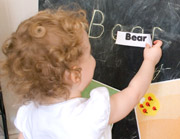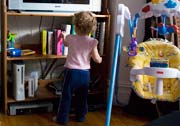

We thought it would be another couple of years at least until our daughter would begin her journey to reading. After a silly experiment we never expected to work it looks like she could already be on her way.

We have started a little experiment teaching our 18 month old daughter to read, and have no idea how it's going to turn out. As I write this article we are a week into the experiment, and are amazed at the results so far. If any of you think there is any value in following along and adding your own ideas and experiences it would be interesting to get your feedback.
We imagine a lot of parents would have already tried similar experiments themselves. It's bound to have occurred to a good percentage of people so if you have done this in the past get in touch and let us know what works and what doesn't.

Perhaps I should explain the thinking that led us to this experiment, and then the actual techniques and results so far. As I said our daughter is 18 months old, and is developmentally pretty normal compared to her friends. She loves books, and is always going to the book shelf and bringing us books to us to read for her.
She has been doing this for approximately the last 6 or 7 months, I remember the first month it was always the same book 'Noddy'. Clare and I grew to hate that book, thank goodness our daughter's taste in books has now become more eclectic. She always turned the pages (sometimes back and forth in big clumps at once, although now page by page) and pointed to the pictures asking us what they depicted.
Some of the drawings were very poor, at times even I found it difficult to discern what they depicted. From book to book a cow would look markedly different, and as I knew my daughter had never seen a real cow I assumed my efforts were futile. Once you told her a particular picture was a 'Dog' for example, next time she saw that picture she would point and say 'Dog'. Some pictures you would have to remind her a few times, but in the main she got it right first time. This I thought was just her memorising one particular drawing and assigning it a name, no big deal (although like any parent I was still very proud).
Very quickly though she was telling us what the pictures were without us telling her. In the case of a sheep (which she calls a baar) I found it amazing as she had no concept of what a real sheep was. At first I though Clare may have told her what the pictures were when I wasn't there and she had just memorised multiple pictures of sheep. That theory was out of the window when we took a drive and heard her shouting 'baar' and pointing to the first real sheep she had seen in a nearby field.
Three months ago she received a blackboard from her grandparents for Christmas. After I had assembled it she wanted to use it as a house rather than a blackboard. To show her what it was I drew a poor quality picture of a Cat on it in white chalk. I said jokingly 'Tell me what that is and I'll buy you a Pony', 'CAT' she replied. The moment was caught on video camera so I now owe her a pony, I think I may get away with a toy one though.
I quickly started drawing other animals, a car, a watch, and other words I'd heard her say. She guessed almost all of them, and could even point out the tail, ear, foot, nose, mouth etc.
Although I'm proud of all of her achievements, it wasn't identifying objects she already knew through a drawing that really impressed me. We have a couple of dogs and a cat, I would expect her to identify a good drawing of a dog or a cat. It was the things she had never seen in real life that impressed me. After seeing a pretty badly drawn pig and told it was a pig she could then find the pig in another book. Even though it was drawn completely differently.
I was showing Clare a particularly badly drawn horse, commenting they may as well have just written 'Horse' as no toddler would recognise it as a horse. It was then that I started wondering, as she could associate drawings with the names of objects, could she also associate the written words with those objects? I thought not, but decided to test the theory anyway.

I printed off a set of words I knew were in her vocabulary. Just in case the experiment worked I used a font where the letters looked quite close to the first letters she would learn at school. For example the lower case letter 'a' is a lot different in most fonts than the handwritten version. It often has a little hook on the top.

I then printed the sheet of words and cut them into cue cards. One of our daughter's most used words is 'Bear' so that was the first word I picked out to show her. A few times during the day I showed her the 'Bear' cue card pointed to the word and said 'Bear'. By the end of the day when we asked her what it was she said correctly 'Bear'. I'd pretty much expected that result, as all she needed to do was remember that a little piece of paper is called 'Bear'.
The next day I introduced another cue card 'Cat'. I showed her the 'Cat' card a good few times during the second day and every time she looked at me blankly. I was pretty sure the experiment was not going to work.
On day 3 I showed her both of the cards throughout the day and tried to show her one was 'Bear' and one was 'Cat' she looked more puzzled even than the day before.
On day 4 before we played the game, unprompted she went over and picked up the 'Bear' card, put it over her mouth and said 'Bear'. We played the game a few times and by the end of the day she could identify each of the two cards correctly every time.
I know this doesn't mean she is actually reading, she doesn't even know one letter of the alphabet. She may be doing it by knowing the short word is 'Cat' and the longer one is 'Bear', she may be looking at the shape of the first letter, or perhaps even by the way I've cut them out a little irregularly. I'll never know how she is doing it, but one thing isn't in doubt. She is correctly identifying 2 written words.
On day 5 I introduced a new word 'Hair' which she picked up really quickly. She is very good at 'Hair' and 'Bear' but has started to stumble sometimes at 'Cat' which she was doing much better at the day before. On the whole she did well all day but then started doing it really quickly and getting more wrong.
Before bedtime we tried again and she was only glancing at the words and getting a few wrong. I was always saying 'what's that say?' when I asked her what a particular word was. Clare said 'read it', and every time she said 'read it' or 'read the word' our daughter studied the word and identified it correctly.
To recap she was doing well with 3 words but as her confidence grew she went downhill and started guessing. When we encouraged her to look again she studied the words more and managed to identify them correctly.

On day 6 we introduced a new word 'Eye' which she picked up immediately. All day long she correctly identified 'Bear', 'Hair', and 'Eye' but often stumbled on 'Cat'. At the end of the day I wrote 'Bear' on her blackboard which she did not identify. A few minutes later I looked around and she had picked out the 'Bear' cue card and was banging it on the blackboard over the word 'Bear' I'd chalked on there earlier. She was shouting 'Bear, Bear, Bear'.
At this point we got really excited and grabbed a camera. Clare wrote Hair on the board and said 'read this word', 'Hair' our daughter replied. I'd begun this experiment on my own, but ever since this moment Clare's enthusiasm has outgrown mine and she's pretty much taken over.
On day 7 we played the game a few times, not the blackboard game but the original 'read the word' game with the cue cards. We played it about 10 times, 3 times she didn't want to play so we stopped. 2 times she got stuck on Cat but got the other 3 words correct, and 5 times she got all 4 correct.
We tried to play the game backward, putting all the words on the table and asking her to bring us the 'Bear' for example. So far this hasn't been successful, she just picks up all of the words and gives them to us en masse.
This brings us right up to date, and the experiment continues. Clare is asking when we are going to add another word, I think perhaps tomorrow we will add 'Bag' as it's a word she uses a lot. I think the experiment has been very interesting. To identify animals from basic illustrations our daughter has obviously figured out for herself that a cat has a tail, whiskers, and pointy ears on the top of it's head. Or perhaps she uses other features to distinguish between a cat from say a dog, whatever the method she hasn't learned it from us.
We feel the same could be true for words. Perhaps she will figure out for herself words are made of letters, and the letters used and the order of those letters follow certain rules to make up the sound of the spoken word.